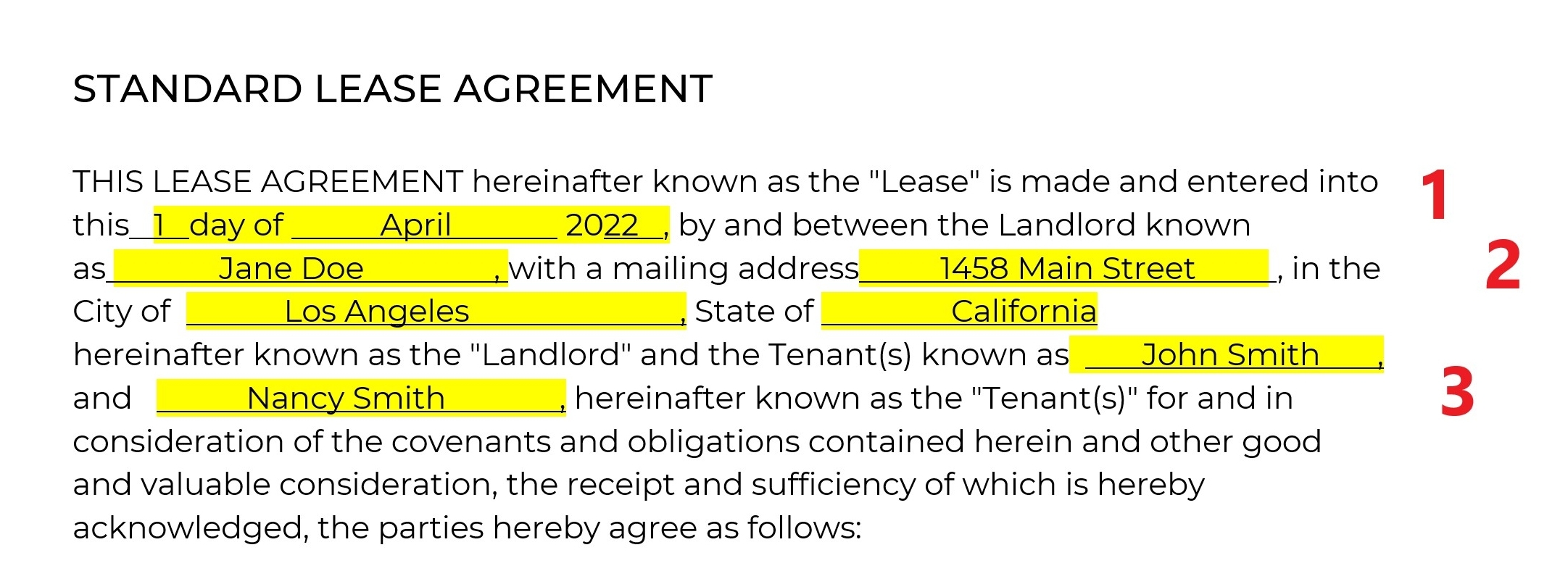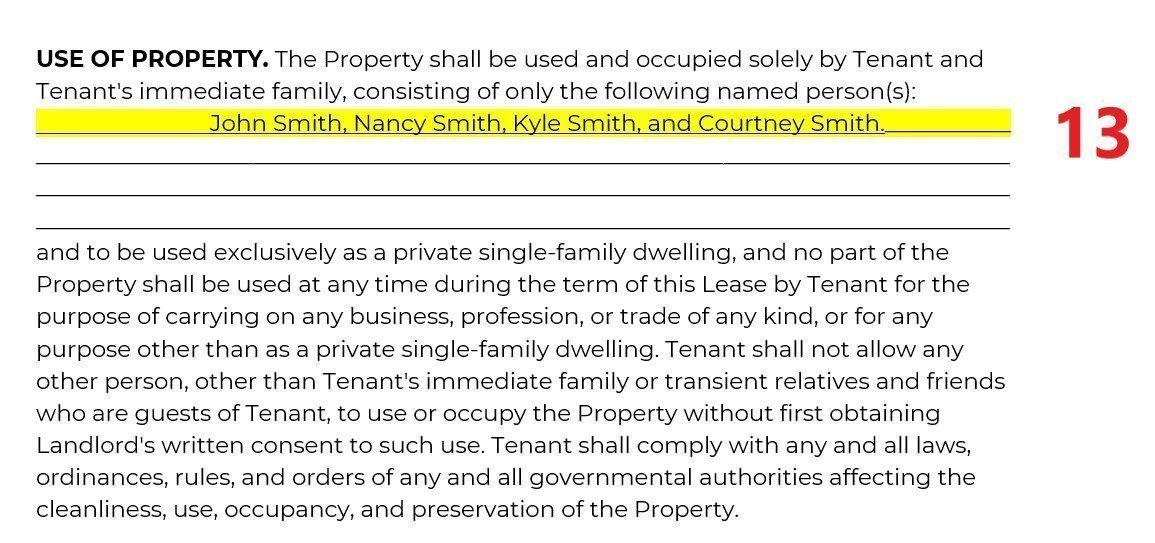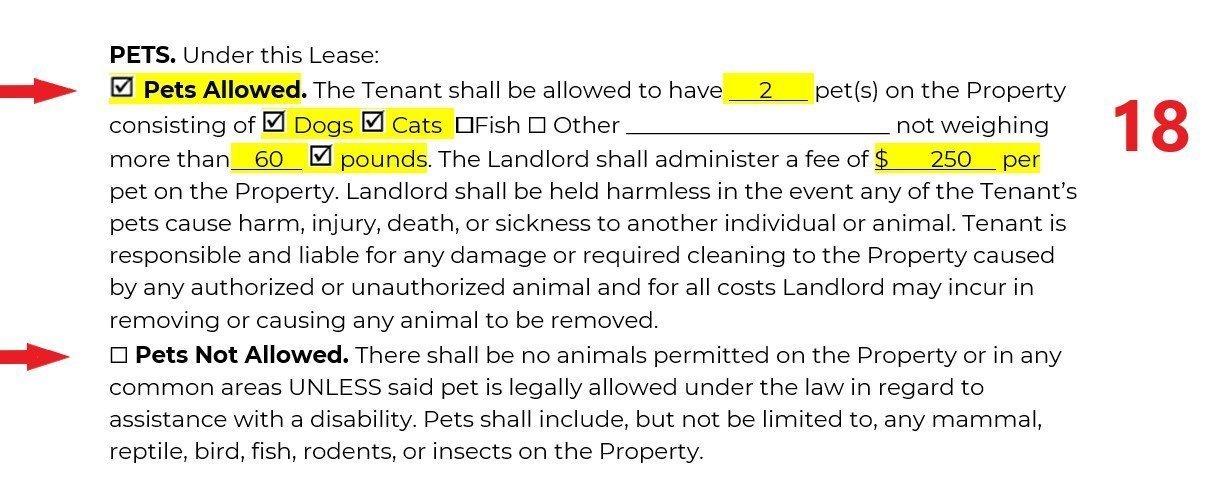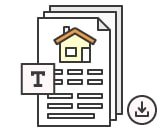Residential Lease Agreement

A standard residential lease agreement (or “rental agreement”) is a contract for a tenant to use a landlord’s residential property in exchange for paying rent. A rental agreement must include specific details such as the periodic rent and the responsibilities of each party.
Residential Lease Agreements by State
Types of Residential Lease Agreements
A rental agreement allows a tenant to live in a residential property in exchange for a rent payment to the landlord. There are many different kinds of rental agreements, suited to different tenant needs and rental situations.
- Standard/Fixed Term – The most common lease agreement is a fixed term agreement. This is a lease for a specific, often extended period of time such as one year. Rent payments come due every month in most fixed term leases. A fixed term lease can be as simple as one page, or detailed and complicated as desired by the parties.
- Month-to-Month – A rental agreement which typically lasts for 30 days, renewing automatically at the end of each month unless the landlord or tenant provide a certain amount of advance notice.
- Sublease – This is where a tenant on an existing lease rents some or all of their rental property to a new, third-party tenant. Landlords usually have a strong preference for a direct business relationship with the person occupying their property, so subleases are often forbidden without the landlord’s prior written permission.
- Roommate – A roommate agreement is not a rental in the strict sense since it doesn’t add a tenant to the lease. The original tenant stays legally liable to the landlord for things like a default on rent. A roommate agreement is a contract between a tenant and a roommate, to arrange division of responsibilities like chores, rent, and utility payments.
- Short-Term (Vacation) – A short term tenancy that typically lasts a few days. May include more responsibilities than typical for a simple overnight rental like a hotel.
- Land Lease – A lease where the tenant owns and operates the residence, but the landlord owns the plot of land underneath. Sometimes also called a ground lease.
- Rent To Own – An agreement where the tenant pays a fee to get the option of purchasing the rental property at the end of the lease. Most rent-to-own agreements credit a portion of the monthly rent to equity in the property if the tenant exercises the purchase option.
Residential Lease Agreement Basics
A residential lease lays out the basic rights and terms that the landlord and tenant agree will govern the occupation of the rental property.
What is the difference between a lease and a rental agreement?
All leases are rental agreements, but not all rental agreements are leases. “Lease” is a term that refers specifically to fixed-term rental agreements.
- Rental Agreement – creates a tenancy for a period of time in exchange for rent. Most residential contracts specifically called “rental agreements” are typically for a month or a 30-day period. Such month-to-month agreements renew automatically in most cases unless either party provides advance notice to end the agreement. Since the entire agreement renews monthly, landlords have a lot of power to change terms from one payment period to the next.
- Lease – creates a tenancy for an extended period of time, generally 1-2 years. Leases have advantages for both landlords and tenants. A lease guarantees an extended period of paid occupancy, which is good for landlords. It also provides stable, predictable terms for things like rent, which is good for tenants.
Can a tenant rent without a written lease?
Most states do allow rentals based on oral agreements, but this is legally risky. Terms of an oral lease can be difficult to prove in court when there’s conflicting testimony. In addition, many states require written leases by law for any rental contracts of one year or longer. Landlords on an oral lease may also have serious limitations on things like the amount of security deposit they can legally collect.
Can parties draft their own rental agreements themselves?
Every state lets a landlord and tenant write their own rental agreement according to their preferred terms. However, ignorance of the law is not an excuse; required and prohibited rental terms remain the same , no matter who drafts the agreement. For maximum safety, a rental agreement must use a professionally drafted template and also receive a specialized attorney review before execution.
Typical Lease Terms
A lease agreement or rental agreement outlines the basic rules and terms to which both the landlord and tenant agree. These are examples of important information to include in every lease or rental agreement.
- Names of Tenants/Landlords – Tames of all tenants, plus the landlord and/or the landlord’s agent authorized to manage the rental property.
- Means of Contact – Smooth and clear communication is the most effective way to reduce conflicts in rental situations. In addition to an address of record for written notice and rent payments, it’s important for a rental agreement to specify any acceptable alternative means of contact, like text or email.
- Occupancy Limits – Most residential property has a legal occupancy limit. Landlords can also limit occupancy on rentals however they choose, but this must be specified in the rental agreement.
- Type of Tenancy – To avoid an unfavorable interpretation over lack of clarity, a rental agreement must clearly state what type of tenancy it intends to create (month-to-month, fixed-term, etc.), including start and end dates.
- Payment of Rent – Details acceptable payment methods (check, online card payment, etc.), the amount owed, and the due date. Any late fees or charges for returned checks must also be detailed in the lease terms.
- Deposits and Fees – The specific terms of any security deposit (amount, allowed deductions, return, etc.) must be detailed, in compliance with local and state laws. Any non-refundable fees like pet or cleaning fees must be clearly disclosed, as well.
- Repairs and Maintenance – Any rental agreement should clearly describe the different responsibilities landlord and tenant have when it comes to maintaining the rental property. This includes both occasional repairs as well as regular maintenance like cleaning the property or changing smoke detector batteries. Note that a landlord’s repair responsibilities are often determined by state law.
- Landlord’s Access To the Property – Landlords have not only the right, but the responsibility to enter rental property for required legal purposes like making necessary repairs. Many states lack comprehensive access laws, so specifying a landlord’s entry rights in the rental agreement is especially important.
- Rules and Policies – Any landlord-enforced rules, regulations, and policies (e.g., smoking restrictions, pet rules, etc.) must be outlined or clearly referenced in the rental agreement. This helps limit a landlord’s liability.
- Disclosures – Depending on the location and specific rental situation, state or federal law may require various disclosures from the landlord to the tenant.
Required Disclosures and Addendums
Required disclosures and addendums vary by state and rental situation. These are the most common required disclosures.
- Lead-Based Paint – Federal law requires notice regarding the risks of lead-based paint in homes built prior to 1978. This requires a specific disclosure form and pamphlet in addition to notice of any known hazards in the building.
- Asbestos – For properties built before 1981, federal law requires notice of any asbestos on the property so that tenants can take appropriate precautions.
- Bed Bugs – Several states require disclosures regarding detection and treatment of bed bug infestations. This type of disclosure is also recommended for rental units with a history of infestation, for liability purposes, even where not required by state law.
- Landlord’s Name and Address – Some states make landlords and their agents provide tenants with a specific contact name, and address of record, for things like notices and rent payments.
- Mold Disclosure – Some states have specific requirements for disclosing mold issues and treatment.
- Shared Utilities Arrangements – When rental units share utilities, there may be statutory requirements for transparency on the specifics of how they are shared, and how each party’s bill is calculated.
- Move-In Checklist – To retain a security deposit, a number of states require that the landlord provide an inspection with an itemized list of property features. This clarifies the condition of the property upon move-in, so that it’s obvious what the tenant has to pay for at the end of the lease term.
- Refundable/Non-Refundable Fees – Non-refundable fees generally must be disclosed as such in the lease. Tenants can otherwise often demand a refund at the end of the lease.
- Smoking – Depending on a property’s situation and local laws, there may be limitations which must be respected on what a smoking policy can allow or prohibit. In particular, states which have medical marijuana programs may have special regulations on residential use policies.
- Late and Returned Check Fees – Many states limit fees a landlord can charge for late payments or bounced checks. Such fees must usually also be disclosed in the lease to be valid.
Illegal Terms in a Rental Agreement
While state contract laws give wide leeway for landlords and tenants to set their own rental terms and conditions, potentially abusive provisions aren’t allowed. A landlord who includes prohibited terms in a lease might be subject to a lawsuit, or even criminal penalties in some extreme cases.
These are some examples of lease terms which often are illegal.
- Warranty of Habitability – Every state has minimum quality standards for housing, usually called a “warranty of habitability.” Landlords have a legal obligation to repair rental property up to these minimum standards. It’s illegal to try and waive a warranty of habitability. Note that in most cases, landlords don’t have to repair damage tenants themselves caused negligently or deliberately.
- Charging Penalties Instead of Fees – Late fees and other nonrefundable fees must be outlined in the lease or rental agreement. Fees in the lease cannot be designed as a punishment; they must reasonably reflect the actual costs related to an inconvenience.
- Security Deposit – The most common type of rental dispute is a disagreement over deductions from the security deposit. Many states regulate the terms under which a landlord can keep part of the security deposit. In general, tenants cannot be charged for damage they did not cause, costs the landlord did not incur, or normal wear and tear of the property.
How to Fill Out a Residential Lease Agreement
Below is a step-by-step process on how to fill out a lease agreement.
Section I. The Parties
- Date – The date of signature for the agreement.
- Landlord’s Contact Information – The landlord’s name and address.
- Tenant’s Names – State the tenant(s) full name(s).

Section II. Location of the Premises
- Tenant’s Names – The full names of any and all tenants responsible for the lease.

Section III. Lease Term
- Lease Term – A clear statement of when the lease begins and ends.
- Termination Notice – Include the notice period required before terminating a month-to-month tenancy created after the lease ends.

Termination Notice – Include the termination notice period.
Section IV. Rent
- Monthly Rent Due – The price of rent due per month.
- When Rent is Due – The date rent is due (typically, the first day of each month).
- Late Fees and Grace Periods – Most states allow a late fee if rent is not paid on time. If there is a late fee, enter the fee details plus when rent is considered late.
- Returned Checks – A fee for a bounced check with non-sufficient funds (NSF). If there is a fee, enter the amount per bounced check. Note that many states set a maximum cap on returned check fees.
- Rent Increase – The effective date of any rent increase.

Section V. Security Deposit
- Security Deposit – Most leases collect a security deposit, generally equal to one month’s rent. Each state’s security deposit law indicates what a landlord can use the money for and the maximum allowed amount.

Section VI. Use of Property
- Occupants – All tenants who are allowed to occupy the property (not including temporary guest stays). This section lists anyone living on the rental property for an extended period, including children.

Section VII. Subletting
- Assignment – A check in the appropriate box allows or denies permission for the tenant to sublet the rental property. Note the specific amount of advance notice to which a landlord is entitled when getting details about an upcoming subtenant.

Section VIII. Right of Entry
- Landlord Access – While state laws regarding landlord access vary widely, in general landlords can enter rental property for relevant purposes during normal business hours. In most cases, they must provide advance notice before a non-emergency entry, typically 24 hours.

Section IX. Non-Delivery of Possession
- Non-Delivery of Possession – Provides a time limit within which the landlord must deliver initial possession of the rental property to the tenant. This protects the tenant’s rights in case there’s an issue like the previous tenant refusing to move out. This limitation on the start date of lease may be required under some state or local laws.

Section X. Utilities
- Utilities – Indicates which utilities and services the landlord will provide to the tenants. Any utility or service not mentioned in the lease is, by default, the tenant’s responsibility.

Section XI. Pets
- Pets – Indicates whether pets are allowed in the rental unit, and relevant restrictions on things like breed or weight. Any nonrefundable pet fees must be disclosed here. Landlords cannot charge any fees for lawful support and service animals, but can require proper documentation before admitting them to a rental property.

Section XII. Default
- Default – Provides terms for ending the lease, including the amount of advance notice before termination or a formal default on rent payment. Note that these notice periods may be fixed by state or local law.

Section XIII. Notice
- Notice – Landlords must make themselves easy to contact for things like rent payment and repair requests. This field provides an address of record for streamlined contact between the landlord and tenant.

Section XIV. Parking
- Parking – Indicates whether the tenant receives a parking space as part of the lease as well as location and the terms on which the space is provided.

Section XV. Early Termination
- Early Termination – Indicates whether the tenant may break the lease early, as well as the notice and cost requirements. Some jurisdictions regulate the maximum early termination fee. Note that termination fees don’t apply if a tenant ends the lease due to landlord violations.

Section XVI. Smoking
- Smoking Policy – Describes the smoking policy for the rental property, including any designated smoking areas.

Section XVII. Signatures
- Signatures – The landlord and every adult tenant must sign the rental agreement to make it effective and binding on all parties. Each party customarily receives a copy of the lease upon execution. This is sometimes also a requirement under state law.

Frequently Asked Questions
What’s the Difference Between a Lease and a Rental Agreement? A rental agreement secures a tenancy for a short period of time, typically a month. Landlords can increase rent, change the terms, or terminate the agreement on short notice. A lease secures a tenancy for a longer period of time, typically a year. During that time, the landlord is not allowed to raise the rent, change the terms or terminate the lease on short notice. Read more » How Much Can a Landlord Collect for a Security Deposit? All states allow landlords to collect a security deposit when a tenant(s) move in. Some states limit the amount a landlord can charge, require the landlord to put security deposits into a separate account or require the landlord to pay their tenants the interest on deposits. Read more » What Can a Landlord Deduct From a Security Deposit? Landlords can use the security deposit to cover unpaid rent and make necessary repairs or cleaning that are not a result of normal wear-and-tear. Security deposits should not go towards treating normal wear and tear during an occupancy. Read more » Do I Need a Written Lease or Rental Agreement? Leases and rental agreements should always be written, even if a state does not require them to be. While oral contracts may seem informal, they often lead to disputes. If a tenant and landlord later disagree about an important arrangement the end result is likely to be a court argument over who said what. Read more »
Other Rental Templates

Month-to-Month Rental Agreement

Rental Application Form

Residential Sublease Agreement

Lease Termination Letter

Room Rental Agreement

Commercial Lease Agreement




















![]()
![]()
![]()
![]()
![]()
![]()